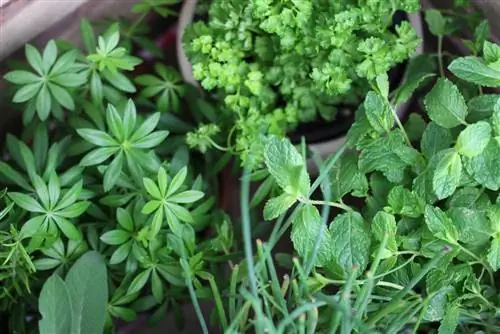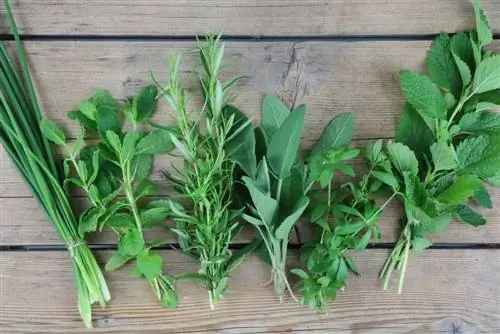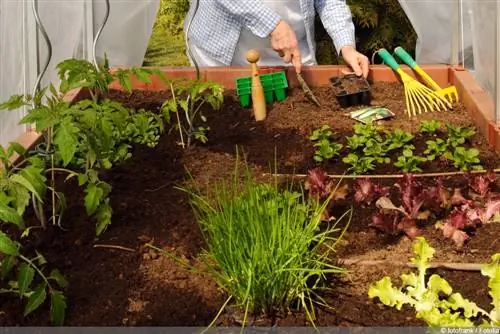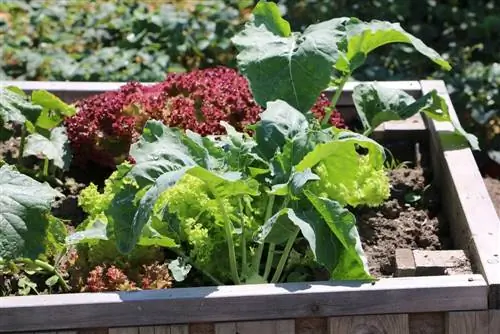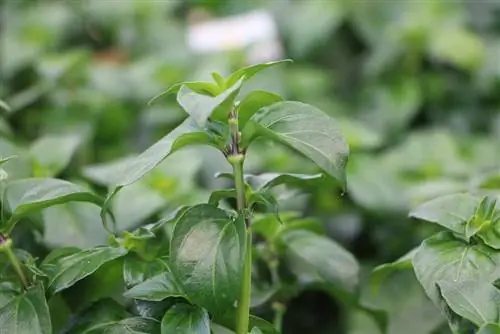- Author admin [email protected].
- Public 2023-12-17 03:39.
- Last modified 2025-01-24 12:45.
A herb bed on the terrace or balcony for direct use in the kitchen or tasty tomatoes that set accents is what every hobby gardener who perhaps only has a little space in a small corner wants. A mortar tray is the ideal planter that fits into many corners, can be used as a small raised bed and therefore also offers a beautiful eye-catcher. Mortar trays are available at any hardware store in a variety of sizes and shapes and can be spruced up a bit before planting.
Preparation
As always with projects like this, the planning begins. First, the available space must be measured and one or more appropriately sized mortar trays purchased. Mortar trays are available in round or rectangular shapes with different capacities. You can choose between a capacity of 12 liters up to 40 liters. You also need to get the following for the bed:
- Styrofoam, old packaging can be used for this
- Expanded clay from hydroponics
- Sand
- sufficient soil
- depending on what is to be planted, for example herb soil, potting soil or garden soil
- compost to mix in depending on the soil used
- Plant fleece
- Covering, for example roof battens
- Wood color according to your own taste
required materials
- Cordless drill
- Hammer and nails
- Brush
Tip:
If the mortar tray is placed on a mobile base before filling with soil, it can be moved to another location at any time, for example from the terrace to a garage for the winter. For round tubs, the bucket rollers for planters are suitable; for rectangular tubs, you can also use a rectangular base with wheels, which are available at hardware stores, to move heavy furniture.
Getting started
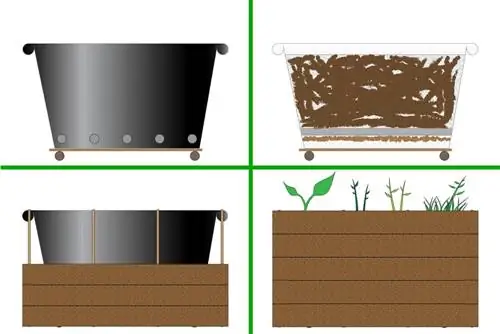
The mortar tray must be prepared before the soil can be filled. For this purpose, holes are made around the lower edge of the side surfaces. Make sure the spacing is even and drill about five to six holes. In this way the excess irrigation water can drain away. Then the bucket is placed on the bucket roller. Break the Styrofoam into small pieces and place in the bottom of the tub. Alternatively, Lecaton (expanded clay), stones or larger pebbles can be used as drainage. Then proceed as follows:
- The plant fleece is placed on top so that the soil cannot block the drainage
- Mix soil with sand and Lecaton or gravel to make it more permeable
- If you don't use special commercially available soil, mix in some compost too
- Fill soil up to just below the edge of the tub
- cut the roof battens to the appropriate bucket height
- paint with the chosen color
- apply around the mortar tray, connecting the wood with cross braces
- make sure that the side walls of the mortar tray are not damaged
- otherwise irrigation water will leak out here later and the wooden border will swell
The planting
After the mortar tray has been prepared and finished, the desired plants and herbs can move in. Since cultivation in a mortar tray is primarily a small raised bed, all plants that are also suitable for such a raised bed are of course suitable for this bed. In addition, there is the chosen location, because depending on whether it is very bright and very sunny or rather in the shade, the appropriate herbs, vegetable plants or blooming flowers and shrubs must be selected.
Before planting, you should also consider which plants are annuals and which are perennials. Because these should not be mixed in one bucket. Tomatoes, peppers and other vegetable plants are annuals and can therefore be easily cultivated together in a pot. Perennial herbs, on the other hand, are planted together in a different tub. The height of growth must also be taken into account. The large plants go towards the back of the wall, the smallest ones go at the front. Further questions before planting should be asked as follows:
- should the herbs and plants be used primarily for the kitchen
- are herbs needed for various healing methods
- or should only fragrant and decorative plants be cultivated
Tip:
If there is enough space and different types of plants and herbs are to be cultivated, it is a good idea to arrange several mortar trays of different sizes and shapes together or in different corners.
Suitable plants and herbs
Many different herbs and plants are suitable for cultivation in the bed in the mortar tub. But as already mentioned, the plants in a bed should always fit together. But herbs and plants that have the habit of spreading quickly are also better suited for container planting than for garden bed planting. These include, for example, lemon balm, mint and oregano. Due to the natural stop of the side walls, there is no unhindered expansion. The following herbs and plants, among others, are suitable for cultivation in a mortar tub:
- Chives
- Rosemary
- Thyme
- lovage
- Tarragon
- Sage
which are all perennial herbs.

Vegetable plants that can be cultivated in a pot or bucket and therefore also in a mortar tray are:
- Tomatoes, these like it sunny but not rain and are therefore ideal on a covered but sun-drenched terrace
- Peppers
- Aubergines
- Cucumbers, but must be tied upwards
- Carrots, as they have enough opportunity to grow downwards into the soil in the mortar tray due to its height
- It looks the same with radishes, radishes and other root vegetables
Tip:
If you don't have your own garden but have a terrace or balcony, you can cultivate almost any vegetables and herbs as well as decorative plants in the mortar tray. Above all, trying makes you smart here. If the cultivation of one vegetable doesn't work, then something else will be grown next year.
The pros and cons
Many hobby gardeners are reluctant to use mortar trays, especially for plants that will later be used in the kitchen. When new, mortar tubs give off an unpleasant smell for some people. Therefore, many assume that this cannot be good for the herbs or plants being cultivated. But you can definitely be reassured here, because it looks like this:
- Mortar trays are made from polyethylene or polypropylene
- These substances do not contain any plasticizers that are released into the soil and could therefore be absorbed by the plants
- Smell of the mortar trays comes from the filler, which consists, among other things, of soot
- this is not harmful to plants, including those used in the kitchen
- the smell is not recognizable and noticeable to everyone
- Smell disappears immediately when the mortar tray is filled with earth and covered from the outside
- Mortar tubs are very inexpensive to purchase
- In this way you can avoid balcony boxes, which usually don't have enough depth for the herbs
- If you use mortar tubs, you can create beautiful raised beds for your balcony or terrace in little time
Tip:
If you want to be on the safe side, water the bucket for a few days before using it for the first time, then any toxins that may be present should be transferred to the water and the use of the mortar tub should therefore be safe. The smell also disappears faster this way.
Conclusion
Mortar tubs are an ideal alternative to a homemade herb bed made of wood or to the much smaller flower boxes. Because they are available in many different sizes, are relatively inexpensive despite their size and can quickly be converted and beautified into an eye-catcher on the balcony or terrace. For example, these can be covered with colorful roof battens so that the simple plastic bucket is no longer visible. In this way, there is space in even the smallest corner for a small herb garden, tomatoes, peppers and other vegetable plants and blooming flowers or bushes can also be cultivated. Almost every plant can find its place in a mortar tray, as it is also well suited for deep-rooted plants or root vegetables due to its depth.

